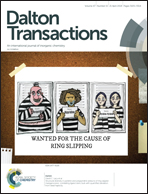Relationship between copper(ii) complexes with FomA adhesin fragments of F. nucleatum and colorectal cancer. Coordination pattern and ability to promote ROS production
Abstract
The copper(II) ion binding of the Ac-KGHGNG-NH2 and Ac-PTVHNE-NH2 fragments of FomA adhesin from Fusobacterium nucleatum was studied using potentiometry, UV-Vis, CD, EPR and DFT techniques. The coordination pattern was described in a wide range of pH values. Ligands begin interactions with metal ions using imidazole nitrogen. At pH 6.8 (a value typical of the large intestine environment), the metal ion was coordinated by the 3N donor atoms {Nim, 2 × N−amide} in both cases. However, the copper(II) ion was bound more effectively by the Ac-PTVHNE-NH2 peptide. The formation of reactive oxygen species (ROS) was studied by UV-Vis and fluorescence spectroscopy, as well as gel electrophoresis in the presence of H2O2 and/or ascorbic acid. The complexes generated ROS in the highest amounts among all compounds. Moreover, they stimulated the CT26 cell line (mouse colon carcinoma) to produce ROS which lead to oxidative stress. It was also determined that such radicals took part in the plasmid degradation mechanism.



 Please wait while we load your content...
Please wait while we load your content...